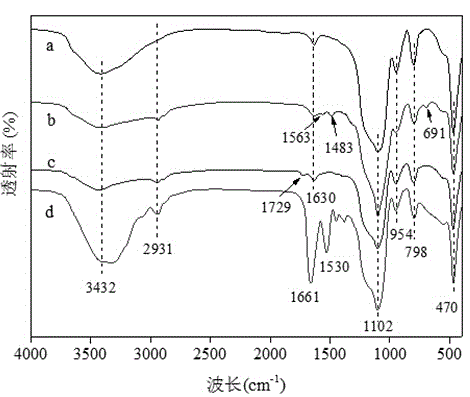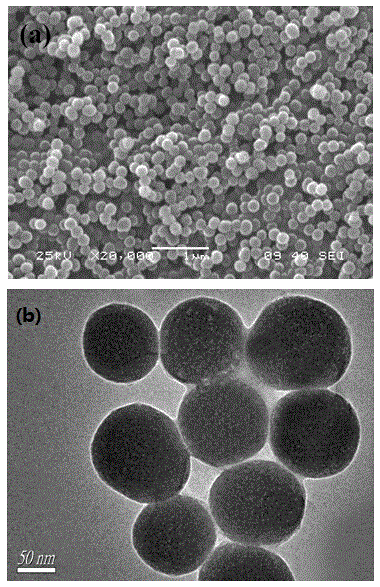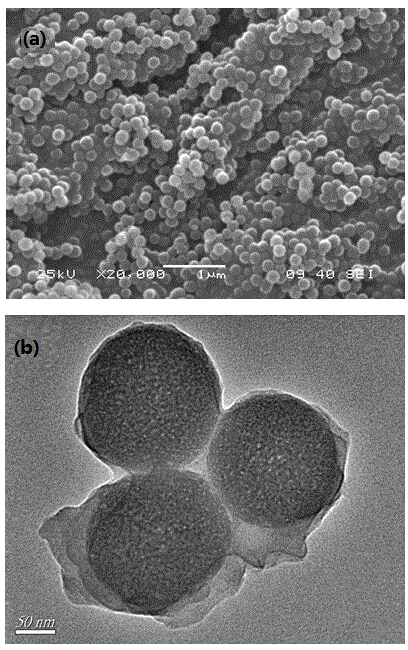Method for preparing ion imprinting polymer by virtue of ultraviolet induced polymerization at room temperature and application of ion imprinting polymer
An ion imprinting, UV-induced technology, applied in chemical instruments and methods, other chemical processes, etc., to achieve the effect of large adsorption capacity, simple operation and good separation effect
- Summary
- Abstract
- Description
- Claims
- Application Information
AI Technical Summary
Benefits of technology
Problems solved by technology
Method used
Image
Examples
Embodiment 1
[0045] (1) Preparation of matrix material Silica
[0046] In a one-necked flask, add 2 mL of water, 5 mL of ammonia water (28%), and 30 mL of absolute ethanol, respectively, and stir for 10 min with a sealed magnetic force. Then take 3 mL of TEOS and place in a beaker containing 20 mL of absolute ethanol. After mixing evenly, the mixture was carefully and quickly added to a single-necked flask, and the mixture was sealed and stirred for 24 h at room temperature. After the reaction, it was separated by centrifugation, washed several times with ethanol and water until the solution was neutral, placed in a vacuum drying oven, and dried under vacuum at 50 °C for 24 h for later use.
[0047] (2) Silicon dioxide surface vinyl modification (Silica-APTS-AC)
[0048] Put 0.2 g of Silica prepared in step (1) into a round bottom flask, add 50 mL of 3 mol L -1 hydrochloric acid, refluxed for 24 h, then filtered, washed repeatedly with deionized water twice until neutral, vacuum dried a...
Embodiment 2
[0058] (1) Preparation of matrix material Silica
[0059] In a one-necked flask, add 4 mL of water, 10 mL of ammonia water (28%), and 60 mL of absolute ethanol, respectively, and stir for 10 min with a sealed magnetic force. Then take 6 mL of TEOS and place in a beaker containing 40 mL of absolute ethanol. After mixing evenly, the mixture was carefully and quickly added to a single-necked flask, and the mixture was sealed and stirred for 24 h at room temperature. After the reaction, it was separated by centrifugation, washed several times with ethanol and water until the solution was neutral, placed in a vacuum drying oven, and dried under vacuum at 50 °C for 24 h for later use.
[0060] (2) Silicon dioxide surface vinyl modification (Silica-APTS-AC)
[0061] Put 0.5 g of Silica prepared in step (1) into a round bottom flask, add 50 mL of 3 mol L -1 hydrochloric acid, refluxed for 24 h, then filtered, repeatedly washed with deionized water twice to neutrality, vacuum-dried ...
Embodiment 3
[0071] (1) Preparation of matrix material Silica
[0072] In a one-necked flask, add 6 mL of water, 15 mL of ammonia water (28%), and 90 mL of absolute ethanol, respectively, and stir for 10 min with a sealed magnetic force. Then take 9 mL of TEOS and place in a beaker containing 60 mL of absolute ethanol. After mixing evenly, the mixture was carefully and quickly added to a single-necked flask, and the mixture was sealed and stirred for 24 h at room temperature. After the reaction, it was separated by centrifugation, washed several times with ethanol and water until the solution was neutral, placed in a vacuum drying oven, and dried under vacuum at 50 °C for 24 h for later use.
[0073] (2) Silicon dioxide surface vinyl modification (Silica-APTS-AC)
[0074] Place 0.4 g of Silica prepared in step (1) in a round bottom flask, add 50 mL of 3 mol L -1 hydrochloric acid, refluxed for 24 h, then filtered, washed repeatedly with deionized water twice until neutral, vacuum dried ...
PUM
| Property | Measurement | Unit |
|---|---|---|
| Saturated adsorption capacity | aaaaa | aaaaa |
Abstract
Description
Claims
Application Information
 Login to View More
Login to View More - R&D
- Intellectual Property
- Life Sciences
- Materials
- Tech Scout
- Unparalleled Data Quality
- Higher Quality Content
- 60% Fewer Hallucinations
Browse by: Latest US Patents, China's latest patents, Technical Efficacy Thesaurus, Application Domain, Technology Topic, Popular Technical Reports.
© 2025 PatSnap. All rights reserved.Legal|Privacy policy|Modern Slavery Act Transparency Statement|Sitemap|About US| Contact US: help@patsnap.com



